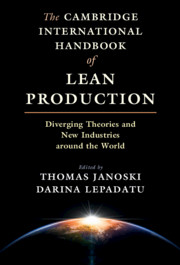 The Cambridge International Handbook of Lean Production
The Cambridge International Handbook of Lean Production Book contents
- The Cambridge International Handbook of Lean Production
- The Cambridge International Handbook of Lean Production
- Copyright page
- Dedication
- Contents
- Tables
- Figures and Sidebars
- Preface
- Acknowledgments
- Contributors
- Abbreviations
- 1 Lean Production as the Dominant Division of Labor
- Part I Theories of Lean Production
- 2 Lean Production from the View of Management Theory
- 3 Lean Production – Perspectives from its Primary Caretaker, Industrial Engineering
- 4 The Industrial Relations Perspective on Lean Systems, Workers, and Unions
- 5 Contested Views of Lean Production from the Social Sciences Perspective
- 6 The Lean Labor Process
- Part II Lean Production across Industries
- Part III Lean Production Around the World
- Name Index
- Subject Index
- References
2 - Lean Production from the View of Management Theory
Functional, Critical, and Paradox Approaches
from Part I - Theories of Lean Production
Published online by Cambridge University Press: 11 March 2021
- The Cambridge International Handbook of Lean Production
- The Cambridge International Handbook of Lean Production
- Copyright page
- Dedication
- Contents
- Tables
- Figures and Sidebars
- Preface
- Acknowledgments
- Contributors
- Abbreviations
- 1 Lean Production as the Dominant Division of Labor
- Part I Theories of Lean Production
- 2 Lean Production from the View of Management Theory
- 3 Lean Production – Perspectives from its Primary Caretaker, Industrial Engineering
- 4 The Industrial Relations Perspective on Lean Systems, Workers, and Unions
- 5 Contested Views of Lean Production from the Social Sciences Perspective
- 6 The Lean Labor Process
- Part II Lean Production across Industries
- Part III Lean Production Around the World
- Name Index
- Subject Index
- References
Summary
Since the publication of a seminal book, The Machine that Changed the World (Womack, Jones, and Roos 1990), lean production has received much attention from numerous researchers and practitioners. Operations Management (OM) studies have greatly increased knowledge on how organizations can successfully implement lean systems, including the Just-in-Time (JIT)/Kanban system (e.g., Monden 2011; Mackelprang and Nair 2010), process improvement programs (e.g., Glover, Farris, Van Aken, and Doolen 2011; Brunet and New 2003), and supply chain management (e.g., Wilhelm, 2011; Bruce, Daly, and Towers 2004). While lean production has been one of the central themes among OM studies (Holweg 2007), this topic has hardly been examined in the Management Theory (MT) literature. This chapter aims to fill this gap by bridging between lean production and MT, and hopes to encourage a larger number of researchers in this field to join the discussion of lean production.
- Type
- Chapter
- Information
- The Cambridge International Handbook of Lean ProductionDiverging Theories and New Industries around the World, pp. 35 - 63Publisher: Cambridge University PressPrint publication year: 2021


